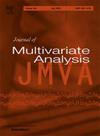广义约秩回归中分数后验的性质
IF 1.4
3区 数学
Q2 STATISTICS & PROBABILITY
引用次数: 0
摘要
降秩回归(RRR)是一种广泛应用的模型,用于研究多个响应变量与一组预测因子之间的线性关系。虽然准备金率在各种工作中得到了广泛的探讨,但重点主要集中在连续响应变量上,而忽略了其他类型的结果。本研究将注意力转移到RRR框架下广义线性模型(GLM)的贝叶斯视角。在这项工作中,我们放宽了广义线性模型的连接函数必须是正则的要求。我们在RRR上下文中研究了GLM中分数后验的性质,其中使用了似然的分数次幂。通过采用光谱尺度的学生先验分布,我们建立了分数后验的一致性和集中度结果。我们的结果突出了适应性,因为它们不需要预先知道参数矩阵的秩。这些结果与频率研究文献中的发现一致。我们还研究了模型错误规范的影响,证明了我们的方法在这种情况下的鲁棒性。数值模拟和实际数据分析表明,与最先进的方法相比,我们的方法具有良好的性能。本文章由计算机程序翻译,如有差异,请以英文原文为准。
On properties of fractional posterior in generalized reduced-rank regression
Reduced rank regression (RRR) is a widely employed model for investigating the linear association between multiple response variables and a set of predictors. While RRR has been extensively explored in various works, the focus has predominantly been on continuous response variables, overlooking other types of outcomes. This study shifts its attention to the Bayesian perspective of generalized linear models (GLM) within the RRR framework. In this work, we relax the requirement for the link function of the generalized linear model to be canonical. We examine the properties of fractional posteriors in GLM within the RRR context, where a fractional power of the likelihood is utilized. By employing a spectral scaled Student prior distribution, we establish consistency and concentration results for the fractional posterior. Our results highlight adaptability, as they do not necessitate prior knowledge of the rank of the parameter matrix. These results are in line with those found in frequentist literature. We also investigate the impact of model misspecification, demonstrating the robustness of our approach in such cases. Numerical simulations and real data analyses are conducted to illustrate the promising performance of our approach compared to the state-of-the-art method.
求助全文
通过发布文献求助,成功后即可免费获取论文全文。
去求助
来源期刊

Journal of Multivariate Analysis
数学-统计学与概率论
CiteScore
2.40
自引率
25.00%
发文量
108
审稿时长
74 days
期刊介绍:
Founded in 1971, the Journal of Multivariate Analysis (JMVA) is the central venue for the publication of new, relevant methodology and particularly innovative applications pertaining to the analysis and interpretation of multidimensional data.
The journal welcomes contributions to all aspects of multivariate data analysis and modeling, including cluster analysis, discriminant analysis, factor analysis, and multidimensional continuous or discrete distribution theory. Topics of current interest include, but are not limited to, inferential aspects of
Copula modeling
Functional data analysis
Graphical modeling
High-dimensional data analysis
Image analysis
Multivariate extreme-value theory
Sparse modeling
Spatial statistics.
 求助内容:
求助内容: 应助结果提醒方式:
应助结果提醒方式:


